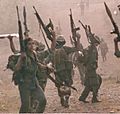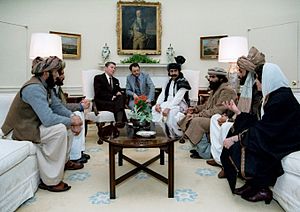Reagan Doctrine facts for kids
The Reagan Doctrine was a big idea in United States foreign policy during the time Ronald Reagan was president. It was all about stopping the worldwide spread of the Soviet Union's influence. This idea was very important from the early 1980s until the Cold War ended in 1991. It shaped how America dealt with other countries for almost a decade.
Contents
What Was the Reagan Doctrine?
The Reagan Doctrine was a plan by the United States to help anti-communist groups around the world. These groups were often fighting against governments supported by the Soviet Union. The goal was to push back against the Soviet Union's power and influence.
Why Was It Created?
The Cold War was a long period of tension between the United States and the Soviet Union. Both countries had different ideas about how the world should be run. The Soviet Union supported communist governments and movements. The United States wanted to stop communism from spreading. The Reagan Doctrine was a strong way for the U.S. to do this.
How Did It Work?
The United States provided money, weapons, and training to rebel groups. These groups were often called "freedom fighters" by the U.S. government. The idea was that by supporting these groups, the U.S. could weaken Soviet-backed governments. This would also make the Soviet Union spend more money and resources, putting a strain on their economy.
Key Places Where It Was Used
The Reagan Doctrine was put into action in several countries. Here are some of the main places:
- Afghanistan: The U.S. supported the Mujahideen fighters. They were fighting against the Soviet army that had invaded Afghanistan. This support helped the Mujahideen resist the Soviets.
- Nicaragua: The U.S. helped the Contras. This group was trying to overthrow the Sandinista government. The Sandinistas were a socialist government that the U.S. saw as being too close to the Soviet Union.
- Angola: The U.S. supported UNITA, a rebel group led by Jonas Savimbi. UNITA was fighting against the Angolan government, which was backed by the Soviet Union and Cuba.
- Cambodia: The U.S. also gave support to groups fighting against the Vietnamese-backed government in Cambodia.
Impact and End of the Doctrine
The Reagan Doctrine was a key part of U.S. foreign policy during the 1980s. Many people believe it played a role in the end of the Cold War. By supporting anti-communist movements, the U.S. put pressure on the Soviet Union. This pressure, along with other problems within the Soviet Union, led to its collapse in 1991.
After the Cold War ended, the main reason for the Reagan Doctrine was gone. The United States no longer needed to actively fight against the global spread of the Soviet Union's influence.
Images for kids
-
U.S. President Ronald Reagan in 1983
-
The U.S.-supported Nicaraguan contras.
-
U.S.-supported UNITA leader Jonas Savimbi.
See also
 In Spanish: Doctrina Reagan para niños
In Spanish: Doctrina Reagan para niños





